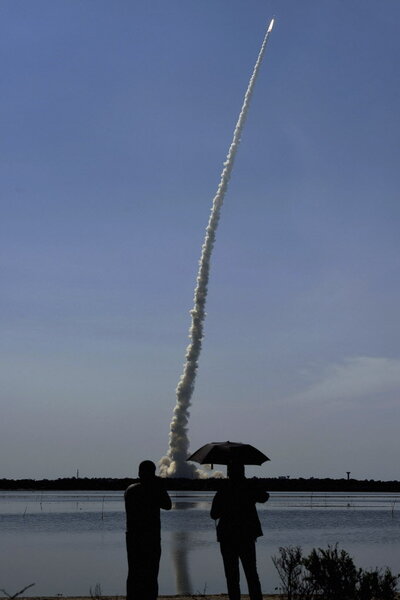What does India's 20-satellite launch mean for space race?
Loading...
The skies just got a little more crowded as India launched 20 satellites into earth's orbit in one mission on Wednesday.
The success marks the largest number of satellites that the nation has launched at one time. India previously held the record for launching 10 satellites in one payload in 2008, yet the United States and Russia have since overtaken that number; Russia now holds the record with 37 satellites launched at once.
Indian Prime Minister Narendra Modi called the event "a monumental accomplishment" for the state-run Indian Space Research Organization (ISRO).
The majority of the 20 satellites, however, are not for Indian use. Rather India has been contracted to plant the satellites in space for a host of customers from other countries with more than half being American-owned.
With its Polar Satellite Launch Vehicle, India is whittling out its piece of the burgeoning commercial launch market, where companies and other clients, often communications companies, pay to have their satellites delivered into orbit. Apart from notable high-volume launches, the South Asian nation has been building clientele by undercutting the competition, Al-Jazeera reports.
"India offers launch costs that are 50 percent cheaper than the rest of the world, so if Space X, Arianespace or NASA can do it at $100, India is willing to do it at $50," Pallava Bagla, a science editor with the privately run Indian TV channel NDTV told Al Jazeera.
The commercial launch industry is not the only area of astronautics where India is stepping into the international fray.
The country’s résumé of notable achievements in space technology has lengthened considerably in recent years as the country focuses more on being part of the $300 million global space industry.
A landmark moment came in September 2014 when India became the first Asian country to reach Mars and the fourth globally, following successful missions from the US, Russia, and Europe, as the Christian Science Monitor's Pete Spotts reported at the time. In 2008, India completed a similar feat, sending a spacecraft into the moon's orbit.
The Mars orbiter was launched in November 2013 and traveled for 300 days before successfully entering into Mars orbit in September 2014, transmitting information about the the atmosphere and surface of the Red Planet back to earth.
Alongside the accomplishment itself, the $75-million price tag attached to India's Mars mission, was notable as well. NASA spacecraft Maven, which entered the orbit around the same time as India’s Mangalyaan, Hindi for "Mars craft," cost a cool $670 million. At the time, Mr. Modi commented that the India's mission cost about as much as the popular 2013 space film "Gravity."
ISRO operates with a budget of about $1 billion, which is 5 percent of NASA's $17.6-billion annual budget, reports the Monitor's Lonnie Shekhtman. However, she writes, India has continued to make notable achievements including the 2015 opening of a space-exploration observatory and last month's launch of an unmanned prototype space shuttle.
That launch was testing reusable launch vehicle technology, which aims to create reusable spacecrafts, which would make space travel more sustainable.
Similar pursuits made headlines as privately owned space companies such as Jeff Bezos' Blue Origin and Elon Musk’s SpaceX have been running trials of reusable rockets. Blue Origin has completed four such successful launches and landings, while SpaceX's fourth is scheduled for the fall.
India is about 15 years away from a fully functioning launch vehicle, according to Smithsonian.com, but the country's reputation in space travel, and commercial satellite launching, is on the rise.
Material from Reuters was used in this report.







